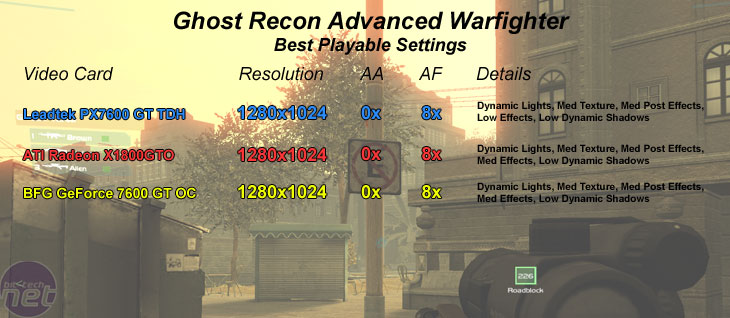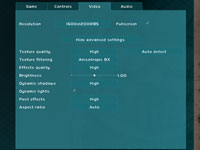Ghost Recon Advanced Warfighter
Publisher: UbisoftWe used the latest addition to Tom Clancy's Ghost Recon series - Ghost Recon Advanced Warfighter and patched the game to version 1.10. This has to be one of the best-looking games on the market at the moment, even despite its lack of support for anti-aliasing on any of today's current hardware. The game makes use of High Dynamic Range lighting and a whole plethora of special effects. Probably the biggest talking point for Ghost Recon Advanced Warfighter is its support for AGEIA's PhysX PPU.
The lack of support for anti-aliasing may seem like a backwards step in image quality, as there are many areas of the game that could certainly benefit from a multisample anti-aliasing pattern. The lack of anti-aliasing support is due to the fact that the game uses multiple render targets to achieve some of the advanced graphical effects. This is due to the way that the DirectX 9.0 specification was set out, and even if multiple render targets and anti-aliasing could work in harmony, it'd be incredibly costly because every surface in the multiple render target would need to be sampled.
We did a five minute manual run through from the start of the Strong Point level. This incorporates lots of post processing effects, HDR lighting, explosions, gun fire and water, too in order to give the graphics subsystem a good work out. The game has no support for anti-aliasing, but anisotropic filtering was controlled from inside the game.


In order to attain a smooth gaming experience on the Leadtek WinFast PX7600 GT TDH, we had to lower post effects detail, effects and also dynamic shadows. We were really impressed with the way the game looked on these cards, even with reduced detail settings. Gameplay is typically quite slow in GRAW, meaning that a high frame rate isn't paramount. The average frame rate wasn't massively high, but then the minimum frame rate was 20 frames per second. Most of the frames were rendered above 25 fps, meaning that gameplay was very smooth for such a low average frame rate.
Both the BFG Tech GeForce 7600 GT OC and ATI Radeon X1800GTO were playable with slightly higher in game details. We were able to increase the effects detail to medium without suffering from adverse hitches and stuttering when explosions went off close by. One great thing was that we were able to leave GRAW's dynamic lighting enabled on all three video cards without killing the gaming experience drastically.
The only difference between the Leadtek WinFast PX7600 GT TDH and the equally matched 7600 GT OC and X1800GTO was that the explosions were not quite as realistic on Leadtek's 7600 GT. They were not quite as violent and there was less shrapnel flying around after a grenade had exploded.

MSI MPG Velox 100R Chassis Review
October 14 2021 | 15:04







Want to comment? Please log in.